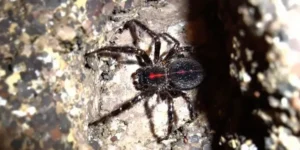Redback spider nests can be quite troublesome. These problematic spiders often establish their habitats close to our residences. A redback spider nest typically resembles an untidy web with a funnel-like structure.
This blog will demonstrate safe methods for removing them. Are you prepared to reclaim your space?
Key Takeaways
- Redback spider nests look messy with funnel-like webs. They hide in dark spots and have egg sacs with about 250 eggs each.
- To remove nests, clean up clutter, seal entry points, use pesticides, and vacuum often. Natural predators like Daddy Long Legs and White-Tailed spiders also help control redbacks.
- For bites, clean the area, apply a cold pack, and seek medical help right away. Don’t use pressure bandages or try to suck out venom.
- Products like Yates Long Term Control Barrier Spray and PestXpert Spider Blast Eliminator can help control redbacks. These sprays last up to 12 months indoors.
- If unsure, call a pro pest control service. They have the right tools and know-how to deal with redback spiders safely and well.

Identifying a Redback Spider Nest

Redback spider nests are typically concealed in dark, protected areas. Search for untidy webs with egg sacs close to the ground or in corners.
Characteristics of Redback Spider Eggs
Redback spider eggs are tiny and white. Female redbacks lay them in silk sacs. These sacs look like small, round balls. Each sac holds about 250 eggs. This results in numerous baby spiders!
Female redbacks can make up to 10 egg sacs in their life. This means they can lay around 2,500 eggs total. The eggs take 2-4 weeks to hatch. After this time, many small spiders emerge.
These baby spiders are prepared to begin their own lives.
Best Methods to Remove Redback Spider Nests
Removing redback spider nests is crucial for home safety. Here are effective methods to eliminate these dangerous pests:
- Clean up outdoor areas. Remove debris, wood piles, and clutter where spiders hide.
- Seal entry points. Repair cracks in walls, windows, and doors to keep spiders out.
- Use door seals and screens. Install fine mesh on vents and windows to block spiders.
- Store items safely. Keep outdoor furniture and toys in sealed containers when not in use.
- Dim outdoor lights. Bright lights attract insects, which draw spiders. Use less lighting at night.
- Apply pesticides. Use spider-specific sprays on nests and hiding spots.
- Vacuum regularly. Remove spiders and webs with a vacuum cleaner.
- Remove webs. Clear spider webs with a broom or duster.
- Use sticky traps. Place glue boards in corners and along walls to catch spiders.
- Try natural repellents. Use peppermint oil or vinegar sprays to deter spiders.
- Prune plants. Trim bushes and trees away from your house to reduce spider habitats.
- Keep a tidy yard. Mow grass often and remove leaf litter to limit spider hiding spots.
Now, we’ll examine the role of natural predators in controlling redback spider populations.
Natural Predators and Their Role
Nature maintains a balance with redback spiders. Daddy Long Leg spiders and White-Tailed spiders are natural predators of redbacks. These native hunters help manage the redback population in the wild.
They capture and consume redbacks, fulfilling an essential role in the ecosystem.
Other creatures also feed on redbacks. Birds, lizards, and certain insects consume these spiders. This natural form of pest management assists in controlling redback numbers. It’s an aspect of the ecological equilibrium.
Now, we’ll examine methods to prevent redbacks from returning.
Preventing Redback Spiders in the Future
To deter redback spiders, repair any cracks or gaps in your home. Install door seals and fine mesh on vents to prevent their entry. Maintain a tidy yard free of clutter. Store outdoor items in sealed containers.
Move furniture inside when not in use. These measures make your area less attractive to spiders.
Minimise outdoor lighting at night. This reduces insects that spiders prey on. Bring shoes, clothes, and toys inside to avoid providing spiders with hiding spots. Remove debris and nesting materials from your yard.
By implementing these strategies, you’ll create an environment that’s far less appealing to redback spiders.
Supplementary Information
We provide additional information to enhance your safety. Continue reading for first aid advice, recommended products, and a useful table of control methods.
First Aid for Redback Spider Bites
Redback spider bites require prompt action. Here are steps to take if you or someone else is bitten:
- Clean the bite area with soap and water.
- Apply a cold pack to ease pain and swelling.
- Keep the person calm and still to slow venom spread.
- Don’t use pressure bandages as they can make pain worse.
- Monitor for symptoms like nausea, vomiting, and sweating.
- Call for medical help immediately, especially for high-risk groups.
- Try to catch or take a photo of the spider for identification.
- Use pain relief like paracetamol if needed.
- Remove tight clothing near the bite site.
- Keep the bitten limb lower than the heart.
- Don’t cut the wound or try to suck out venom.
- Avoid home remedies and wait for proper medical care.
- Note the time of the bite to inform doctors.
- Stay with the person until help arrives.
These steps can help manage a redback spider bite safely. We’ll now examine some products that can help control redback spiders in your home.
Recommended Products for Redback Spider Control
Redback spider control products can help keep your home safe. Here are some top options for managing these dangerous arachnids:
- Yates Long Term Control Barrier Spray remains effective up to 12 months indoors and 3 months outdoors. This spray creates a lasting barrier against spiders.
- PestXpert Spider Blast Eliminator eliminates spiders upon contact. It’s effective for quick removal of visible redbacks.
- PestXpert Pro Spray Outdoor Perimeter establishes a protective barrier around your home. Apply it twice a year in sunny or rainy areas.
- Annual insecticide spray treatments focus on home perimeters and hiding spots. These prevent spiders from entering your living spaces.
- Yates 2L Home Pest Long Term Control Barrier Spray Ready-to-Use costs $29.82. It’s an affordable option for DIY pest control.
- Outdoor pest control sprays deter redbacks from your garden. They make your outdoor areas less appealing to spiders.
- Spider elimination sprays act quickly on visible nests. Use them with care and follow all safety instructions.
- Home perimeter insecticides establish a protective zone around your house. They prevent spiders from getting inside.
- Long-lasting pest control products are time and cost-effective. You won’t need to spray as frequently with these options.
Comparison Table of Redback Spider Nest Control Methods
Comparing different methods to control redback spiders assists homeowners in selecting the most suitable approach. This table shows how various products compare:
| Product | Indoor Effectiveness | Outdoor Effectiveness | Duration |
|---|---|---|---|
| Yates Long Term Control Barrier Spray | High | Medium | 12 months indoor, 3 months outdoor |
| PestXpert Spider Blast Eliminator | Medium | High | 2-3 months |
| PestXpert Pro Spray Outdoor Perimeter | Low | High | 3-4 months |
| Annual Insecticide Spray Treatment | High | High | 6-12 months |
Each method has its strengths. The most appropriate choice depends on the area requiring protection. Next, we’ll discuss situations that warrant professional spider control services.
Contacting Professional Pest Control Services
Need assistance with redback spiders? Contact a professional pest control service promptly. They possess the expertise and equipment to address your spider concerns efficiently. Ensure your safety and maintain a spider-free environment by obtaining expert assistance promptly.
For excellent information on redback spiders, visit RedBackSpider.com.
Conclusion
Managing redback spider nests requires care and attention. With proper knowledge, you can maintain a safe home environment. Prioritise safety when addressing these arachnids. If uncertain, engage professional pest control services.
They possess the equipment and expertise to resolve the issue efficiently. Remain vigilant and respond promptly to prevent redback infestations. Your diligence will result in a living space free from these spiders.
FAQs
1. How do I spot a redback spider nest?
Look for messy webs in dark, quiet spots… like under outdoor furniture or in garden sheds. These eight-legged critters love to hide away. You might see egg sacs – small, round, and white – tucked into the web. Keep an eye out, especially in summer when they’re most active.
2. What’s the safest way to get rid of Redback Spider Nest?
Safety first, mate! Slip on some thick gloves and long sleeves. Use a long-handled broom to knock down the webs. Then, vacuum up the mess. For stubborn nests, try a spider spray from the shop. Always read the label and follow the rules. If you’re not sure, call in the pros.
3. Can I use natural methods to deter redbacks?
Too right! Redbacks hate strong smells. Try peppermint oil or vinegar mixed with water in a spray bottle. Spritz around your yard and home. Keep your space tidy – less clutter means fewer hiding spots. Seal up cracks and gaps where they might sneak in. It’s a win-win: your place looks better and the spiders stay away.
4. How often should I check for new Redback Spider Nest?
Make it a habit to have a good look around every few weeks, especially in the warmer months. After rain is a top time to check – spiders often move to drier spots then. Don’t forget to peek in those hard-to-reach corners. Regular checks mean you’ll catch new nests early, making them easier to deal with. Stay on top of it, and you’ll keep those redbacks at bay!





